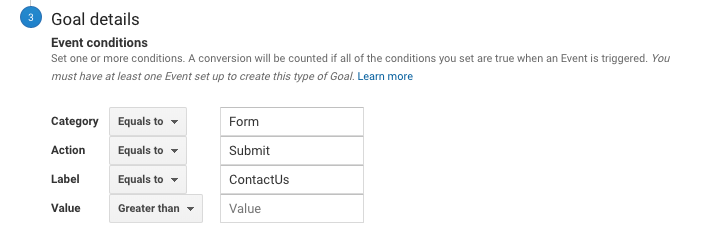Learn What Data Is Google Analytics Goals Unable to Track
Learn What Data Is Google Analytics Goals Unable to Track
Blog Article
Revealing the Blind Destinations: Comprehending What Google Analytics Goals Can not Determine
In the world of digital analytics, Google Analytics stands as an effective device for tracking and analyzing online individual interactions. Amidst its robust abilities, there exist blind areas that frequently evade measurement. what data is google analytics goals unable to track. Understanding what Google Analytics objectives can not gauge is crucial for obtaining a thorough sight of customer habits and involvement. As we look into the ins and outs of these dead spots, we discover a complicated web of undiscovered areas that hold useful understandings right into individual actions and motivations, tough standard knowledge and losing light on the restrictions of our data-driven understanding.
User Actions on External Platforms
Recognizing exactly how users engage on external systems is essential for maximizing on the internet approaches. Outside systems, such as social media networks, recommendation websites, and on the internet discussion forums, play a considerable duty in driving traffic to a firm's site. By assessing user habits on these systems, businesses can obtain useful insights into the performance of their advertising initiatives and the preferences of their target audience.
One trick element of individual actions on external platforms is the referral resource. By tracking where the users are originating from, organizations can determine which platforms are driving one of the most traffic to their website. This information can assist business allot their resources much more successfully, concentrating on the systems that yield the very best results.

Offline Conversions and Interactions
Analyzing customer actions on outside platforms provides beneficial insights into on-line methods; nonetheless, taking into consideration offline conversions and interactions is equally imperative for a comprehensive understanding of a business's total performance. Offline conversions, such as in-store acquisitions or phone questions, play a significant role in several services' success.

Attribution Beyond Last Click
When delving into the world of electronic marketing analytics, it ends up being vital to look past the solitary touchpoint of the last click for a more extensive understanding of attribution. While Google Analytics supplies beneficial understandings right into user behavior, depending exclusively on last-click acknowledgment can be restricting - what data is google analytics goals unable to track. Acknowledgment versions that exceed the last click offer a more nuanced view of the client journey, considering all the touchpoints that cause a conversion
Attribution beyond the last click allows online marketers to designate debt to numerous communications along the conversion path, giving a clearer picture of the performance of various advertising channels. By exploring multi-touch attribution versions such as direct, time decay, or position-based acknowledgment, organizations can much better assign their marketing budgets and maximize their techniques for maximum influence.
Recognizing the impact of each touchpoint in the conversion process is crucial for making informed decisions and making the most of ROI. By welcoming acknowledgment past the last click, organizations can gain deeper understandings into consumer actions and tailor their advertising and marketing initiatives better.
Cross-Device and Cross-Browser Tracking

Likewise, cross-browser monitoring enhances cross-device tracking by capturing user habits as they change in between various internet browsers. Understanding exactly how individuals engage with internet sites on numerous browsers can help online marketers enhance their on the internet experiences to make sure uniformity and performance throughout various systems.
Qualitative Information and Customer Intent
Recognizing customer intent via qualitative information evaluation is critical for creating targeted electronic advertising and marketing methods that reverberate with the requirements and preferences of the target audience. Qualitative data provides insights right into the 'why' behind customer activities, dropping light on motivations, emotions, and choices that measurable information alone can not catch. By evaluating user comments, comments, and communications, online marketers can discover important information over here about customer intent, permitting them to tailor their messaging, content, and offerings to much better line up with what their audience is looking for.
Qualitative data also aids in recognizing the context in which individuals engage with a website or application. This contextual understanding allows online marketers to develop even more pertinent and customized experiences, ultimately driving greater engagement and conversion prices. By delving right into individual intent via qualitative information analysis, services can acquire a much deeper understanding of their target audience, leading to a lot more effective advertising and marketing techniques that fulfill individuals' demands and expectations.
Verdict
Finally, Google Analytics objectives have restrictions in gauging individual actions on outside systems, offline conversions, attribution past last click, cross-device and cross-browser tracking, and qualitative data connected to individual intent. what data is google analytics goals unable to track. It is very important for companies to be mindful of these unseen areas in order to supplement their information evaluation with other tools and techniques to gain a more detailed understanding of their audience and improve their general electronic marketing techniques
By examining customer behavior on these platforms, services can obtain valuable insights into the efficiency of their advertising and marketing efforts and the preferences of their target audience.
Evaluating individual habits on exterior systems provides important understandings right into on-line strategies; however, taking into consideration offline conversions and communications is equally necessary for a comprehensive understanding of a business's total performance.In digital advertising analytics, moving past last-click acknowledgment to discover cross-device and cross-browser tracking is crucial for gaining a holistic understanding of customer communications throughout various platforms and devices. By examining customer responses, remarks, and interactions, marketing experts can reveal beneficial information regarding individual intent, permitting them to customize their messaging, material, and offerings to much better align with what their audience is seeking.
By diving into user intent through qualitative information evaluation, companies can acquire a deeper understanding of their target audience, leading to more reliable advertising and marketing methods that satisfy users' expectations and demands.
Report this page